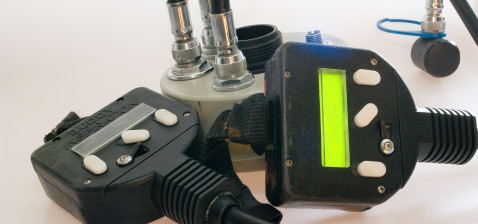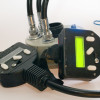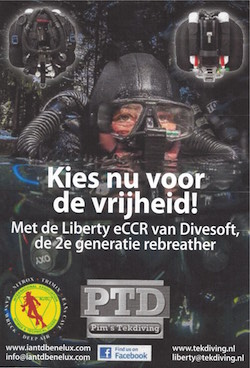Inspiration Classic

Closed Circuit eCCR //
1 August
READ THIS FIRST!
| Name: | Inspiration Classic |
| Manufacturer: | Ambient Pressure Diving |
| Website: | http://www.apdiving.com/ |
| Since: | 1997 |
| Type: | eCCR |
| CE: | Yes |
| Lungs: | Over The Shoulder |
| Weight: | 29 kg (ready to dive) |
| Scrubber duration: | 3 hours, radial canister, 40m, air, 4 degrees C. 1.6l/min CO2 (big radial scrubbers are optional) |
| Weight Scrubber: | 2.5 kg |
| ADV (Automatic Diluent Valve): | Optional |
| HUD (Head Up Display): | No |
| BOV (Bail Out Valve): | No |
| (Deco-) computer: | No |
| Tanks: | 3l |
| My deepest dive with the unit: | 140 mtr (Bunaken, Indonesia) |
| Price: | 5.500 EUR (ex shipping, incl. taxes |
| General: 4 stars | Some history: the Classic (at that time it was named the Buddy Inspiration…) was my first CCR. I bought it second hand. For my training I went to the UK: to Kevin Gurr. Because of the fatal accidents on the unit and the colour of its housing, it was called the yellow box of death… With my Inspiration I was banned from major dive events and dive trips (on boats). Luckily times have changed! Now it is possible to dive CCR’s all over the world and even hire units from holiday resorts. That was unthinkable only 10 years ago… Nowadays charters prefer CCR’s over OC, because they take less space and need less gas. The Classic hasn’t changed a lot from its first appearance in 1997. However training on the unit has improved enormously and such reducing the percentage of accidents. Nowadays the Inspiration is the best selling unit in the world (estimates are 3000 – 4000 units sold). Ambient Pressure Diving is far-out the market leader for of CCR’s. The company of Martin Parker (Ambient Pressure Diving) was and still is setting the standards for rebreather design: dual monitors, over the shoulder lungs, 2.5 kg canister (with 3 hour duration @ 1.3 PO2 gives 100% CNS…), high/low setpoint, temp stick (on the Vision), separated power supply, etc. But Martin also had to pay a price: numerous lawsuits against him and his company from people who wanted to sui him for liability. He won all of the lawsuits and never gave up in producing, improving and selling his units. The unit is easy to use, has good breathing properties, good buoyancy, good after sales and support. And it’s cheap. |
| 1. Ease of use (set-up, maintenance) 4 stars | It is very easy to start up the unit. Calibration is fully automatic. The unit calibrates on oxygen. The displays have limited functionality and therefor easy to operate. |
| 2. Buoyancy/trim 3 stars | Trim is good, when the top weights are in place. The lungs are over the shoulder. The diver has a tendency to be vertical. But shifting and placing weights in the good places, makes it easier to keep a horizontal position. |
| 3. WOB 3 stars | The WOB is good. Mostly due to the placement of the lungs. I guess that the breathing hose could be wider. |
| 4. Travel (modularity) 3 stars | The housing/case makes it somewhat difficult to put in a bag. However the head with the handsets can be easily removed and put in the hand luggage. Tanks are widely available with CCR friendly dive resorts and charters. |
| 5. Safety 3 stars | Safety is ok. An APD Autoair (a second stage integrated with the inflator of the BCD) is standard. Most technical divers remove the Autoair, because the 3 ltr onboard is not enough to make a an ascent (with deco). However it could be used for sanity breaths. It is difficult to give the Autoair to a buddy. The Autoair can never replace bailout (after 18 mtrs). The unit doesn’t turn on automatically. If the diver forgets to turn on the unit he/she will get hypoxic and die. The unit not being turned on by the diver caused several fatalities. An ADV is optional. I think it should be standard. |
| 6. Price 5 stars | The Inspiration Classic is probably the cheapest CE approved eCCR in the market. |
| 7. Service/after sales/availability parts 5 stars | Spare parts are quickly available with the manufacturer and the distributors. Many dive stores sell parts (on line). Also (CCR friendly) dive resorts often have spare parts on stock. APD also has one of the best websites for their units (downloads, video’s, maintenance, etc.). |
| 8. Build quality 3 stars | The housing is good. A lot of plastic. The breathing hose “feels” soft. |
| 9. Cave diving 3 stars | No problem. However nit many cave divers use an Inspiration. |
| 10. Deep and X-treme diving 3 stars | The unit is CE rated until 100 mtrs. At 140 mtrs the buzzer (for the audible alarms) tends to implode. When the buzzer is removed, one can dive the unit deeper. |

